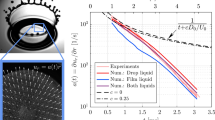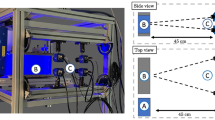Abstract
The focus of the current study is to examine experimentally the diffracted shock wave pattern and the consequent vortex loop formation, propagation, and decay from nozzles having singular corners. Non-intrusive qualitative and quantitative techniques: schlieren, shadowgraphy, and particle image velocimetry (PIV) are employed to analyze the induced flow-fields. Eye-shaped nozzles were used with the corner joints representing singularities. The length of the minor axes are a = 6 and 15 mm, with the major axis b = 30 mm for both cases. The experiments are performed for flow Reynolds numbers in the range 0.8 × 105 and 4.6 × 105. Air is used in both driver and driven sections of the shock tube.

















Similar content being viewed by others
References
Anderson JD (1990) Modern compressible flow, with historical perspective, 2nd edn. McGraw-Hill, Inc, New York
Archer PJ, Thomas TG, Coleman GN (2008) Direct numerical simulation of vortex ring evolution from the laminar to the early turbulent regime. J Fluid Mech 598:201–226
Arakeri JH, Das D, Krothapalli A, Lourenco L (2004) Vortex ring formation at the open end of a shock tube: a particle image velocimetry study. Phys Fluids 16:1008–1019
Baird JP (1987) Supersonic vortex rings. Proc R Soc Lond A 409:59–65
Bergdorf M, Koumoutsakos P, Leonard A (2007) Direct numerical simulations of vortex rings at \(Re_{\Upgamma}=7500.\) J Fluid Mech 581:495–505
Broadbent EG, Moore DW (1987) The interaction of a vortex ring and a coaxial supersonic jet. Proc R Soc Lond A 409:47–57
Brouillette M, Hebert C (1997) Propagation and interaction of shock-generated vortices. Fluid Dyn Res 21:159–169
Bykovets AP, Repin VB (1980) Formation of a vortex rings at the open end of a pulsed chamber. Combustion, Explosion, Shock Waves 16:73–77
Chatterjee A (1999) Shock wave deformation in shock-vortex interactions. Shock Waves 9:95–105
Dazin A, Dupont P, Stanislas M (2006) Experimental characterization of the instability of the vortex rings. Part II: Non-linear phase. Exp Fluids 41:401–413
Dhanak MR, DeBernardinis B (1981) The evolution of an elliptic vortex ring. J Fluid Mech 109:189–216
Ding Z, Hussaini MY, Erlebacher G, Krothapalli A (2001) Computational study of shock interaction with a vortex ring. Phys Fluids 13:3033–3048
Dziedzic M, Leutheusser HJ (1996) An experimental study of viscous vortex rings. Exp Fluids 21:315–324
Golub VV (1994), Development of shock wave and vortex ring structures in unsteady jets. Shock Waves 3:279–285
Grinstein FF, DeVore CR (1996) Dynamics of coherent structures and transition to turbulence in free square jets. Phys Fluids 8:1237–1251
Holman JP (1994) Experimental methods for engineers. McGraw-Hill, Inc, New York
Howard LN, Matthews DL (1956) On the vortices produced in shock diffraction. J Appl Phys 27:223–231
Hillier R (1994) Computation of shock wave diffraction at a ninety degrees convex edge. Shock Waves 1:89–98
Jiang Z, Onodera O, Takayama K (1999) Evolution of shock waves and the primary vortex loop discharged from a square cross-section tube. Shock Waves 9:1–10
Krothapalli A, Rajkuperan E, Alvi F, Lourenco L (1999) Flow field and noise characteristics of a supersonic impinging jet. J Fluid Mech 392:155–181
Kontis K, Kounadis D, An R, Zare-Behtash H (2008) Vortex ring interaction studies with a cylinder and a sphere. Int J Heat Fluid Flow 29:1380–1392
Kontis K, An R, Zare-Behtash H, Kounadis D (2008) Head-on collision of shock wave induced vortices with solid and perforated walls. Phys Fluids 20
Liu Z, Zheng Y, Jia L, Zhang Q (2005) Study of bubble induced flow structure using PIV. Chem Eng Sci 60:3537–3552
Maxworthy T (1972) The structure and stability of vortex rings. J Fluid Mech 51:15–32
Melling A (1997) Tracer particles and seeding for particle image velocimetry. Meas Sci Technol 8:1406–1416
Mirels H (1955) Laminar boundary layer behind shock advancing into stationary fluid. NACA TN 3401
Minota T (1993) Interaction of a shock wave with a high-speed vortex ring. Fluid Dyn Res 12:335–342
Minota T, Nishida M, Lee MG (1997) Shock formation by compressible vortex ring impinging on a wall. Fluid Dyn Res 12:139–157
Moore DW (1985) The effect of compressibility on the speed of propagation of a vortex ring. Proc R Soc Lond A 397:87–97
Nakashima Y, Inoue O (2008) Sound generation by a vortex ring collision with a wall. Phys Fluids 20:126104
Ohyagi S, Obara T, Hoshi S, Cai P, Yoshihashi T (2002) Diffraction and re-initiation of detonations behind a backward-facing step. Shock Waves 12:221–226
Ortiz-Villafuerte J, Schmidl WD, Hassan YA (2000) Three-dimensional ptv study of the surrounding flow and wake of a bubble rising in a stagnant liquid. Exp Fluids 29:S202–S210
Oshima Y, Izutsu N, Oshima K, Hussain AKMF (1988) Bifurcation of an elliptic vortex ring. Fluid Dyn Res 3:133–139
Prangé R, Pallier L, Hansen KC, Howard R, Vourlidas A, Courtin R, Parkinson C (2004), An interplanetary shock traced by planetary auroral storms from the Sun to Saturn. Nature 432:78–81
Raffel M, Willert CE, Kompenhans J (1998) Particle image velocimetry. Springer, Berlin
Settles GS (2001) Schlieren and Shadowgraph techniques. Springer, Berlin
Shepherd JE, Schultz E, Akbar R (2000) Detonation diffraction. In: Ball G, Hillier R, Roberts G (eds) Proceedings of the 22nd international symposium on shock waves 1, pp 41–48
Shimizu T, Watanabe Y, Kambe T (2000) Scattered waves generated by shock wave and vortex ring interaction. Fluid Dyn Res 27:65–90
Shusser M, Gharib M (2000) Energy and velocity of a forming vortex ring. Phys Fluids 12:618–621
Sivier S, Loth E, Baum J, Löhner R (1992) Vorticity produced by shock wave diffraction. Shock Waves 2:31–41
Sun M, Takayama K (2003) Vorticity production in shock diffraction. J Fluid Mech 478:237–256
Tam C, Ahuja KK (1990) Theoretical model of discrete tone generation by impinging jets. J Fluid Mech 214:67–87
Takayama F, Ishii Y, Sakurai A, Kambe T (1993) Self-intensification in shock wave and vortex interaction. Fluid Dyn Res 12:343–348
Takamoto M, Izumi K (1981) Experimental observation of stable arrangement of vortex rings. Phys Fluids 24:1582–1583
Tokugawa N, Ishii Y, Sugano K, Takayama F, Kambe T (1997) Observation and analysis of scattering interaction between a shock wave and a vortex ring. Fluid Dyn Res 21:185–199
Weigand A, Gharib M (1994) On the decay of a turbulent vortex ring. Phys Fluids 6:3806–3808
Wilson J, Sgondea A, Paxson DE, Rosenthal BN (2007) Parametric investigation of thrust augmentation by ejectors on a pulsed detonation tube. J Propulsion Power 23:108–115
Yoon JH, Lee SJ (2003) Investigation of the near-field structure of an elliptic jet using stereoscopic particle image velocimetry. Meas Sci Technol 14:2034–2046
Zhao W, Frankel SH, Mongeau LG (2000) Effects of trailing jet instability on vortex ring formation. Phys Fluids 12:589–596
Acknowledgments
The authors are indebted to the technical staff at The University of Manchester for their assistance and for the help and advice of Dr. Martin Hyde (TSI) for the installation and setup of the PIV system. The support of the EPSRC Engineering Instrument Pool especially Mr. Adrian Walker, for the loan of the PIV system, is greatly acknowledged.
Author information
Authors and Affiliations
Corresponding author
Rights and permissions
About this article
Cite this article
Zare-Behtash, H., Kontis, K., Gongora-Orozco, N. et al. Shock wave-induced vortex loops emanating from nozzles with singular corners. Exp Fluids 49, 1005–1019 (2010). https://doi.org/10.1007/s00348-010-0839-7
Received:
Revised:
Accepted:
Published:
Issue Date:
DOI: https://doi.org/10.1007/s00348-010-0839-7




